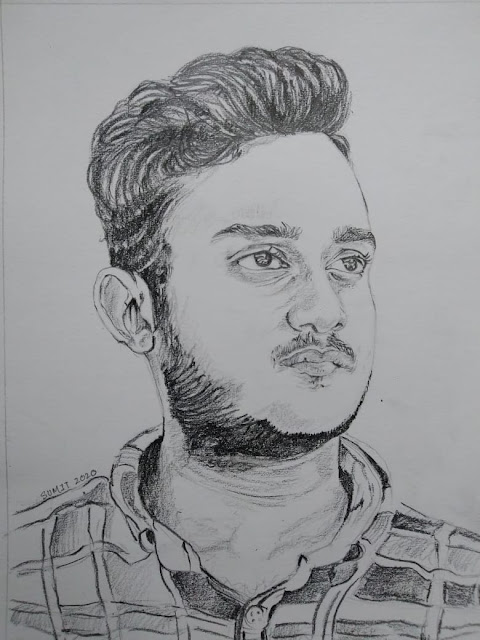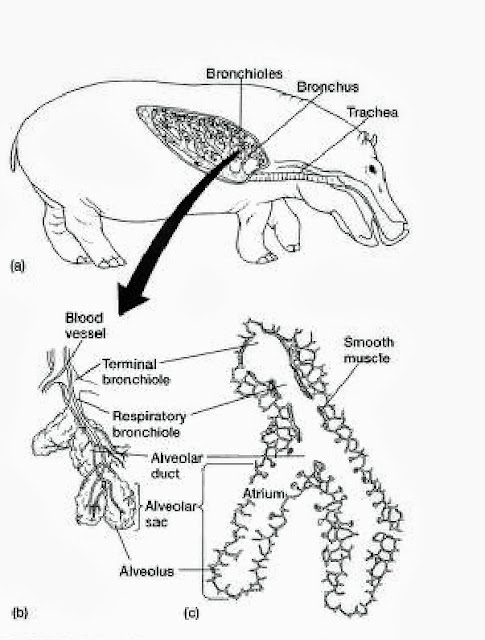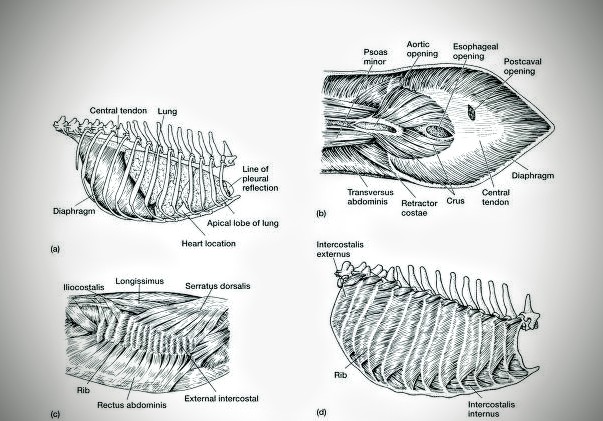Birds have
two lungs connected to a trachea and ventilated by an aspiration pump (https://sumit012001.blogspot.com/2020/03/respiration-process-in-mammals.html
) .
Lungs are paired , pink coloured ,
saccular , non elastic spongy organs of respiration .
STRUCTURE :
v The trachea is divided into two primary bronchi , ( = mesobronchi ) that do not enter the lung but
extend posteriorly to reach the posterior air sac .
v Along the way , the primary bronchi
give rise to numerous branches , the most prominent of which include latero ,ventro, and dorso bronchi
as well as secondary bronchi . These
leads to the parabronchi ( Figure – 11.36 a – c )
vThe wall of the parabronchi
consists of an anastomosing network of air capillaries , each only a few
thousands of a millimeter in diameter , surrounded by blood capillaries . It is
the lining of the air capillaries that constitutes the respiratory epithelium .
v During passage through the
parabronchus , gases diffuse between the lumen
of the parabronchus and the connecting , blind – ended air capillaries .
Oxygen diffuse in turn from the air capillaries into the adjacent blood
capillaries that give up carbon dioxide to the air capillaries. Thus the walls
of air and blood capillaries constitute the sight of gas exchange .
AIR SAC :
v Nine avascular air sacs are
connected to the lungs .
v Generally , the anterior air sacs
include the single interclavicular sac and
the paired cervical and anterior thoracic air sacs .
v The posterior air sacs include the
paired posterior thoracic and paired
abdominal air sacs ( Figure – 11.35
a )
Although lungs and gills are the primary respiratory organ ¸
the skin can supplement breathing .
Respiration through the skin , referred to as cutaneous respiration , can take
place in air , in water, or in both. So many vertebrates are involved in
cutaneous respiration .
( Fig – 1 Cutaneous
respiration among vertebrates )
- In the European eel and plaice , oxygen uptake through the skin may account for up to 30% of total gas exchange .
- Bats take advantage of cutaneous respiration across their well – vascularized wing membrane to eliminate as much as 12% of their total carbon dioxide waste , but they take up only 1% or 2% of their total oxygen requirement through this cutaneous route ( Fig – 1 ) .
- Sea snakes can supplement up to 30% of their oxygen intake via cutaneous respiration across the skin on their sides and back .
- In fact , in salamanders of the family plethodontidae , adults lack lungs and gills and depend entirely on cutaneous respiration to need their metabolic needs .
- In modern amphibians , the skin is a major respiratory organ , The skin is moist and the layer of keratin relatively thin , allowing easy diffusion of gases between the environment and the rich supply of capillaries within the integument (Fig – 2 (b) (c) .
( Fig – 2 Adaptation for cutaneous respiration . Many vertebrates exhibit complex or elaborate
specializations that enhance the efficiency of gas exchange through the skin . (a) While still small , this fish larva
, Monopterus albus , occupies the thin layer of water
adjacent to the surface where oxygen
levels are relatively high . Its pectoral fins beat , forcing water to flow
across its body surface . Blood circulating
through the skin flows in the opposite direction from the water , establishing
a countercurrent exchange between blood
and water. (b) In the lake Titicaca
frog , Telmotobius culeus , prominent loose skinfolds on its
back and limbs provide extensive surface area for cutaneous respiration . (c) In the male hairy frog , Astylosternus robustus , numerous
papillae appear during the breeding season , forming a ruffled supplementary
respiratory organ on its sides and hindlimbs .
The newly
hatched larva of the teleost fish Monopterus
albus , an inhabitant of southeast Asia , uses predominantly cutaneous
respiration during its early life . At hatching , the large and heavily
vascularized pectoral fins beat in such a fashion as to drive a stream of water
backward across the surface of the larva and its yolk sac . Blood in
superficial skin vessels courses forward . This establishes a countercurrent
exchange between water and blood to increase the efficiency of cutaneous
respiration of this larva ( Fig – 2 (a) .
Vertebrate lungs are designed for air
breathing . Lungs are elastic bags that lie within the body. Their volume
expands when air is inhaled and decreases when air is exhaled .
Air
ventilation : Aspiration pump
( Fig – 1 Air
breathing amniotes : Aspiration pump . In most amniotes , the buccal
cavity has little to do with forcing air in or out of the lungs . Instead a rib
cage expands and compress and / or a diaphragm moves forward and back within
the body cavity to create a positive pressure that expels air or negative
pressure that draws air into the lungs . )
The aspiration
pump is a third type , after dual and buccal pumps , that does not push air
into the lung against a resisting force . Rather air is sucked in , or
aspirated , by the low pressure created around the lung ( fig – 1 ). The lungs are
located within the pump so that the force required to ventilate them is applied
directly . The pump includes the rib cage and often a muscular diaphragm . A
movable diaphragm in the thorax causes pressure changes rather than the action
of the buccal cavity . The diaphragm
like a plunger , alters the pressure on the lungs to favor entry or exit of air
.
( Fig – 2 Unidirectional
and bidirectional flow . (a) in fishes and many aquatic
amphibians , water movement is unidirectional because water flow through the
mouth , across the gill curtain , and out the lateral gill chamber . (b) In many air – breathing vertebrates
, air flows into the respiratory organ and then reverses its direction to exit
along the same route, creating a bidirectional or tidal flow.)
The
aspiration pump is bidirectional and moves air tidally . It is found in
amniotes – reptiles , mammals and birds .
Ventilation
mechanism of mammals :
Ventilation
, or breathing , is the active process of moving the respiratory medium , water
or air , across the exchange surface .
An aspiration pump ventilates the lungs of the mammals . Changes in the shape of the rib cage and
piston like action of a muscular diaphragm contributes this pumping mechanism. The
diaphragm consists of crural , costal , and sternal parts , all of which
converge on a central tendon ( Fig – 3 )
(Fig – 3 : (a)
Location of lungs and diaphragm within the rib cage of the dog (lateral view ).
(b) ventral view of the diaphragm ,
which lies behind the lungs and has a dome shape. Notice the opening that allow
anterior – posterior passage of the aorta, esophagus, and postcava .
Superficial (c) and deep (d) muscle of the rib cage
The
diaphragm of mammals lies anterior to the liver , and acts directly on the
pleural cavities in which the lungs reside ( Fig – 3 , (a) , (b). Intercostal muscles
run between the ribs. The transversus abdominies
, serratus , and rectus abdominies that are inserted on the ribs and originate
outside the rib cage ( Fig – 3 (c) , (d) . All aid in the mammalian
ventilation.
Ventilation
through lung :
( Fig – 4 Rib
cage movement in mammals . (a) various muscles run between
adjacent ribs at slanted angles. (b) during
inhalation , external intercostal contract , causing adjacent ribs to be drawn
forward, expanding the pleural cavities around the lungs , and aspirating air
into them. (c) Exhalation is often
passive. Gravity pulls the ribs down , compressing the lungs and expelling air.
During vigorous respiration , exhalation
may be active. When this occurs, internal intercostals , slanted in an opposite
direction , contract to compress the rib cage.
Gas
exchange of mammals :
In mammals , the sites of
respiratory exchange are reached via a different route . The respiratory
passageway ( including trachea , bronchi , bronchioles ) repeatedly divides ,
producing smaller and smaller branches until they finally terminate in blind
ended compartments , the alveoli , which characterize the respiratory bronchioles
and air sac (fig – 5) . The trachea, bronchi and terminal bronchioles that
transport gas to and from the alveoli are called the respiratory tree in
recognition of their branching patterns . Gas exchange occurs in the
bronchioles and alveoli .
In mammals ,
the total alveolar area is extensive, perhaps over ten times that of amphibians
of similar mass . such a large exchange area is essential in mammals to sustain
the high rate of oxygen uptake required by an active endotherm
( Fig – 5 : (a) the
trachea leads to the pleural cavities and branches in to the bronchi to supply
left and right lung . Repeated bronchial branching produce smaller and
smaller bronchioles that eventually leads to alveolar sac. (b) Enlarged alveolar sac , arteries
and veins supply the alveoli to accommodate gas exchange within them. (c) internal subdivision of the
alveolar sacs are shown . Each small compartments in an alveolus where actual
respiratory exchange between blood and air occurs . Note the smooth muscle
bands at the opening .
The alveoli are rich with capillaries , called
alveolar capillaries . Here the red blood cells absorb oxygen from the air and
then carry it back in the form of oxyhemoglobin , to nourish the cells . The
red blood cells also carry carbon dioxide away from the cells in the form of carboxyhemoglobin
and releases it into the alveoli through
the alveolar capillaries . When the diaphragm relaxes , a positive pressure is
generated in the thorax and air rushes out of the alveoli expelling the carbon
dioxide. ( Fig – 5 )
(Fig – 5 Gas
exchange between alveoli and capillaries )
Most of the mammals live in land, so
they use air for the respiratory medium. For the air breathing animal the most
suitable respiratory organ is lung and also other associated organs (
including trachea , bronchi, bronchioles
etc ) are included.
(Fig – 1: In this
diagram respiratory system of human is included. The blue
part of the figure indicates the nose, pharynx and larynx .)
So the air
is breathed through the nose or nostril cavity or mouth.
In the nasal cavity , a layer of mucous membrane act as a filter and traps
pollutants and other harmful substances found in the air.
Next air moves into the pharynx , a
passage that contains the intersection between the esophagus and the larynx . The
opening of the larynx (fig – 1 ) has a special flap of cartilage , the epiglottis , that opens to allow
air to pass through but closes to prevent food from moving in the
Passageway.
( Fig – 2 : (a) the
trachea leads to the pleural cavities and branches in to the bronchi to supply
left and right lung . Repeated bronchial branching produce smaller and
smaller bronchioles that eventually leads to alveolar sac. (b) Enlarged alveolar sac , arteries
and veins supply the alveoli to accommodate gas exchange within them. (c) internal subdivision of the
alveolar sacs are shown . Each small compartments in an alveolus where actual
respiratory exchange between blood and air occurs . Note the smooth muscle
bands at the opening .
From the larynx , air moves
into the trachea ,the trachea is the largest tube in
the respiratory tract and consists of tracheal rings of hyaline cartilage (fig
– 1 ) . It branches off into two bronchial
tubes , a
left and a right main bronchus. It produces smaller and smaller
branches until they finally terminate in blind ended compartments , the alveoli , which characterize the respiratory bronchioles and air sac
(fig – 2)
(Fig – 3 : (a)
Location of lungs and diaphragm within the rib cage of the dog (lateral view ).
(b) ventral view of the diaphragm ,
which lies behind the lungs and has a dome shape. Notice the opening that allow
anterior – posterior passage of the aorta, esophagus, and postcava .
Superficial (c) and deep (d) muscle of the rib cage
The lungs are the
largest organ in the respiratory tract . The lungs are suspended within the
pleural cavity of the thorax , are protected from physical damage by rib cage .
The pleurae are two thin membrane , one cell layer thick , which surround the
lungs . The inner (visceral pleura) covers the lungs and the outer (parietal
pleura) lines the inner surface of the chest wall. This membrane secretes a
small amount of fluid, allowing the lungs to move freely within the pleural
cavity while expanding and contracting during breathing.
At the bottom of the lungs is a
sheet of skeletal muscle called the diaphragm separates the lungs from the stomach
and intestines.
The lungs are divided into
different lobes. The right lung is larger in size than the left, because of the
hearts being situated to the left of the midline .
The alveoli are tiny air sacs in the
lungs where gas exchange takes place . There are about 150 million per lung.
Gas exchange occurs in the bronchioles and alveoli








































